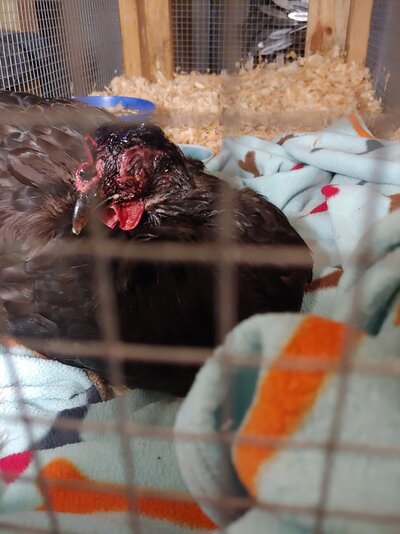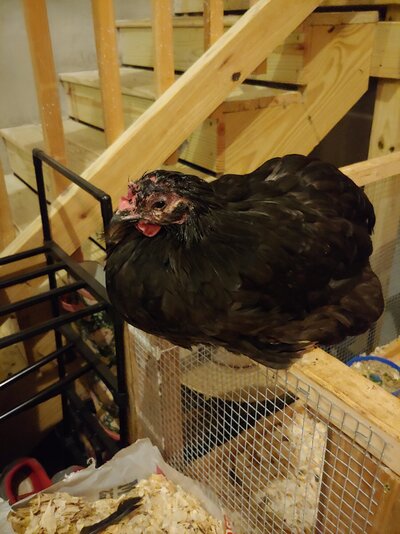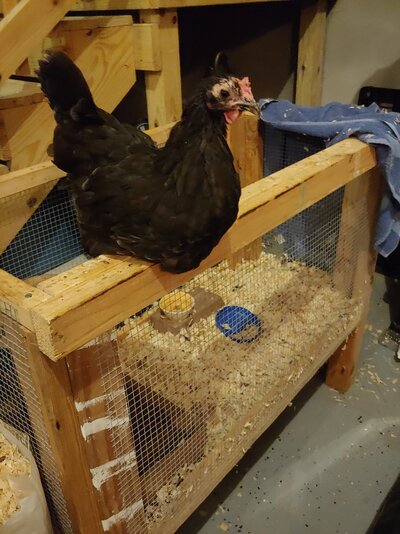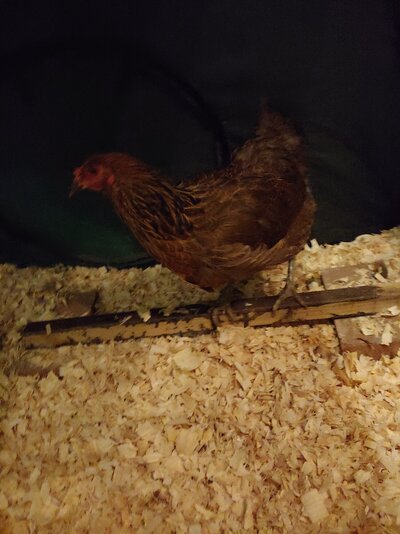marigold38
In the Brooder
- Sep 19, 2021
- 12
- 6
- 14
Back story: This is week two. So, two weeks ago I was sitting in my backyard at 730 at night when I heard chickens screeching. I immed. ran to my coop - no probs. I realized it was my neighbor's coop. I frantically ran to their house, they weren't home. I grabbed my husband, a shovel and ran in their backyard. Sparing the details, we were able to save two out of a flock of eight. It appears to have been a raccoon. My neighbors decided they could not care for injured birds. I welcomed them to my house.
Bird 1: Tulip (the brown hen, last pic) as per neighbor, has survived multiple attacks, she is very scared of me and is quite vocal. She lost her tail feathers and most of her comb. I put antibacterial spray on her comb (just on night one) and am giving her probiotics and electrolytes in water. No other visible injuries. She is currently in a 'chicken tent' in the garage by herself but she can see her other injured flock mate. This is the beginning of week two and she had her first dust bath in the tent and she laid a blue egg for us two days ago! Appears to be fine (relatively speaking).
Questions: Can anyone say definitively what breed she is? EE or Amer.? Also, will her comb grow back fully? Will her missing tail feathers grow back? Will this only happen after a molt?
Bird 2: Clover (we named her this because she is luckier than a 4 leaf clover) She is severely injured. I can't even believe she made it this far. On night one, I worked with what I had on hand, which was Blue Kote (styptic powder was not needed) for lacerations, probiotics and electrolytes in water. The next day I gathered supplies. Cut and Heal Wound Care Liquid (which I love bc it has a a sponge applicator and goes on like an oil and smells like Vicks) which I applied twice a day for almost the entire first week. For the first two days I syringe fed her water with honey, baby aspirin, and electrolytes/probiotics several times a day. Day three, I started syringe feeding her mash crumbles several times a day. I've also kept it warm in the garage since she couldn't regulate her own body temp. About day five she started to turn a corner and was interested in eating on her own. She has had some trouble pecking at food, but her beak looks aligned and in good shape. She seems to be getting better with the pecking now. Her injured eye is fully open now and I assume, functioning. She seems interested in her flock mate that is in the tent beside her (she is in a large cage/brooder). So, at bedtime I put her in with her sister and they roost side by side. In early morning, I put her back in her brooder, until all her wounds heal.
Here's my most important question: Bird 2 (Clover) really smells. I mean like rotten fish. I have lifted up wings, poked around her vent, checked her all over. I see absolutely no visible signs of infection. Also, she is acting so much better every day. Does anyone have a clue as to why she smells so bad? I don't know if she smelled this way from day 1 bc I was so much more concerned with the injuries.
Plan going forward: We have made a separate area in our run for these two (we only have a flock of 4) and we are building them their own coop this weekend. They will move outside for a few hours at a time once all wounds are healed.
Question: Should I make the less injured bird wait to go outside until her flock mate is fully healed as well? After a full integration regimen is followed, will my original flock accept the two new birds if they have no combs, look different from their injuries?
I wanted to post this so I can can get a clue as to the smell issue, and have a few questions answered, but also I hope this awful story maybe can help someone else if they ever find themselves in a similar situation. Thanks in advance for any answers.
Bird 1: Tulip (the brown hen, last pic) as per neighbor, has survived multiple attacks, she is very scared of me and is quite vocal. She lost her tail feathers and most of her comb. I put antibacterial spray on her comb (just on night one) and am giving her probiotics and electrolytes in water. No other visible injuries. She is currently in a 'chicken tent' in the garage by herself but she can see her other injured flock mate. This is the beginning of week two and she had her first dust bath in the tent and she laid a blue egg for us two days ago! Appears to be fine (relatively speaking).
Questions: Can anyone say definitively what breed she is? EE or Amer.? Also, will her comb grow back fully? Will her missing tail feathers grow back? Will this only happen after a molt?
Bird 2: Clover (we named her this because she is luckier than a 4 leaf clover) She is severely injured. I can't even believe she made it this far. On night one, I worked with what I had on hand, which was Blue Kote (styptic powder was not needed) for lacerations, probiotics and electrolytes in water. The next day I gathered supplies. Cut and Heal Wound Care Liquid (which I love bc it has a a sponge applicator and goes on like an oil and smells like Vicks) which I applied twice a day for almost the entire first week. For the first two days I syringe fed her water with honey, baby aspirin, and electrolytes/probiotics several times a day. Day three, I started syringe feeding her mash crumbles several times a day. I've also kept it warm in the garage since she couldn't regulate her own body temp. About day five she started to turn a corner and was interested in eating on her own. She has had some trouble pecking at food, but her beak looks aligned and in good shape. She seems to be getting better with the pecking now. Her injured eye is fully open now and I assume, functioning. She seems interested in her flock mate that is in the tent beside her (she is in a large cage/brooder). So, at bedtime I put her in with her sister and they roost side by side. In early morning, I put her back in her brooder, until all her wounds heal.
Here's my most important question: Bird 2 (Clover) really smells. I mean like rotten fish. I have lifted up wings, poked around her vent, checked her all over. I see absolutely no visible signs of infection. Also, she is acting so much better every day. Does anyone have a clue as to why she smells so bad? I don't know if she smelled this way from day 1 bc I was so much more concerned with the injuries.
Plan going forward: We have made a separate area in our run for these two (we only have a flock of 4) and we are building them their own coop this weekend. They will move outside for a few hours at a time once all wounds are healed.
Question: Should I make the less injured bird wait to go outside until her flock mate is fully healed as well? After a full integration regimen is followed, will my original flock accept the two new birds if they have no combs, look different from their injuries?
I wanted to post this so I can can get a clue as to the smell issue, and have a few questions answered, but also I hope this awful story maybe can help someone else if they ever find themselves in a similar situation. Thanks in advance for any answers.







